Exhibit 99.7
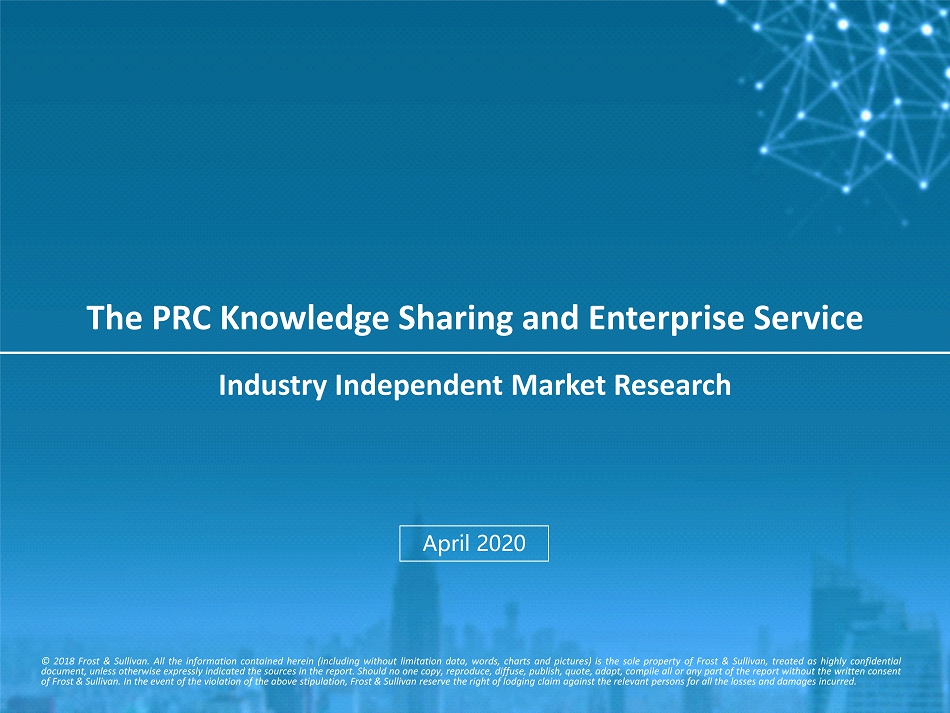
1 The PRC Knowledge Sharing and Enterprise Service Industry Independent Market Research April 2019 © 2018 Frost & Sullivan. All the information contained herein (including without limitation data, words, charts and pictures) is the sole property of Frost & Sullivan, treated as highly confidential document, unless otherwise expressly indicated the sources in the report. Should no one copy, reproduce, diffuse, publish, quote, adapt, compile all or any part of the report without the written consent of Frost & Sullivan. In the event of the violation of the above stipulation, Frost & Sullivan reserve the right of lodging claim against the relevant persons for all the losses and damages incurred.
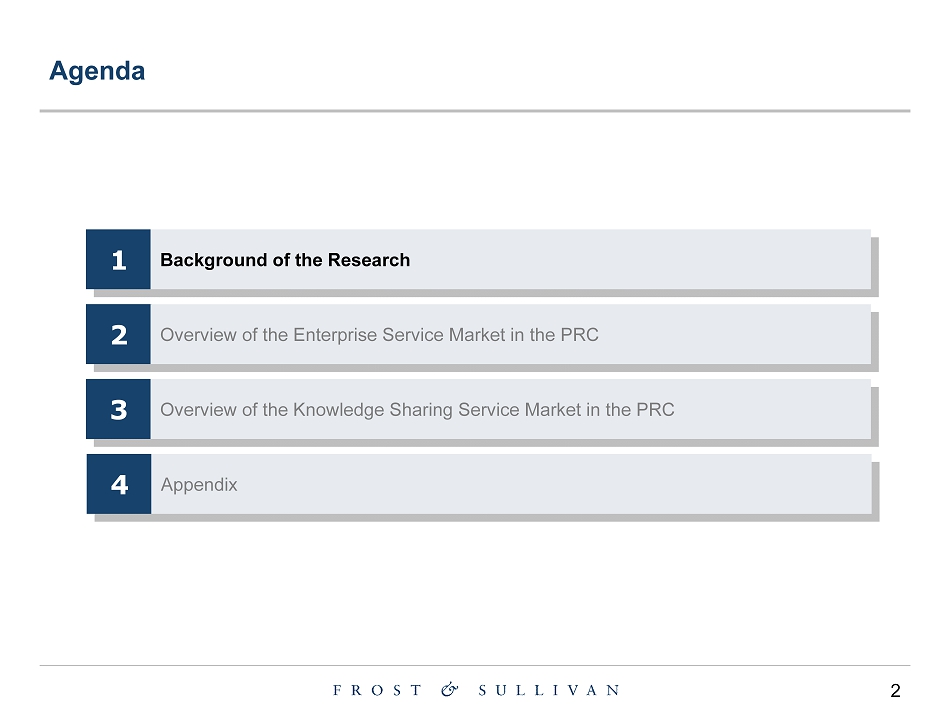
Agenda 2 Overview of the Enterprise Service Market in the PRC 3 Overview of the Knowledge Sharing Service Market in the PRC 1 Background of the Research 4 Appendix 2

Research Period • Historical Year: 2014 - 2018 • Base Year: 2019* ˄ we will use year 2018 if year 2019 data is not available ˅ • Forecast Year: 2020E - 2024E Geographic Scope • The PRC Industry Scope • Enterprise Service in the PRC • The knowledge Sharing Service in the PRC 3 Scope The project scope is defined as follows:
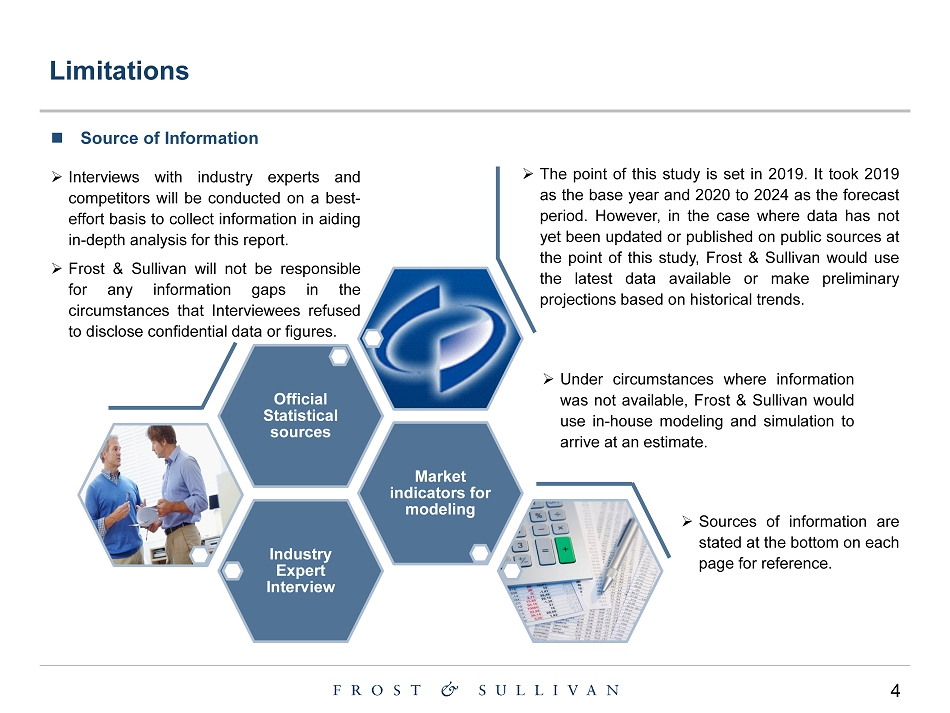
Li m itations Industry Expert Inter v i e w Market indicators for modeling Official Statistic a l sources Source of Information » Interviews with industry experts and competitors will be conducted on a best - effort basis to collect information in aiding in - depth analysis for this report . » Frost & Sullivan will not be responsible for any information gaps in the circumstances that Interviewees refused to disclose confidential data or figures . » The point of this study is set in 2019 . It took 2019 as the base year and 2020 to 2024 as the forecast period . However, in the case where data has not yet been updated or published on public sources at the point of this study, Frost & Sullivan would use the latest data available or make preliminary projections based on historical trends . » Under circumstances where information was not available, Frost & Sullivan would use in - house modeling and simulation to arrive at an estimate . » Sources of information are stated at the bottom on each page for reference . 4
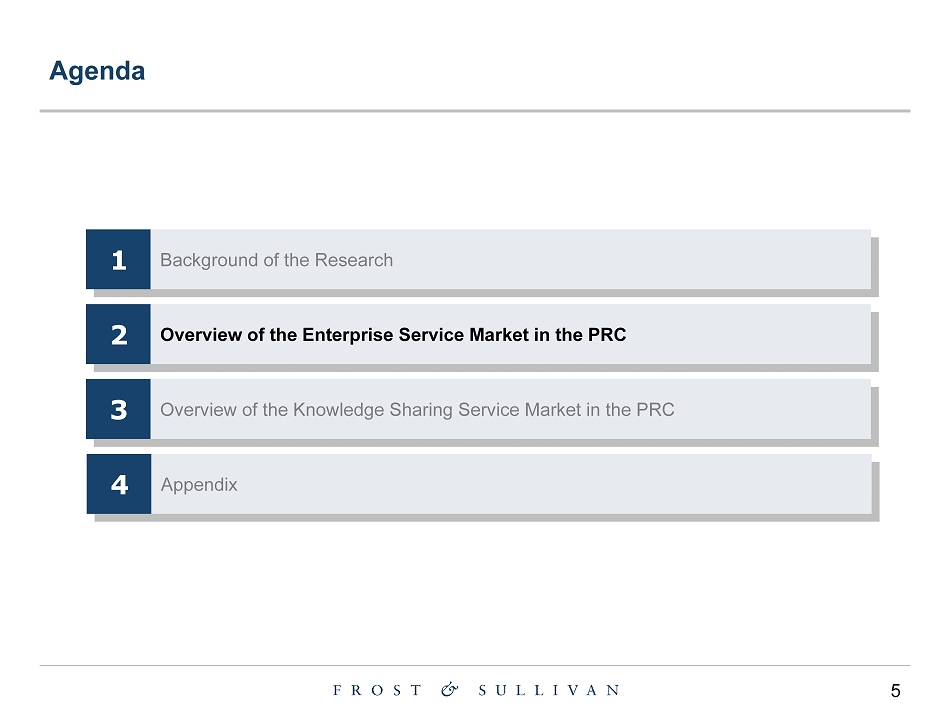
Agenda 2 Overview of the Enterprise Service Market in the PRC 3 Overview of the Knowledge Sharing Service Market in the PRC 1 Background of the Research 4 Appendix 5
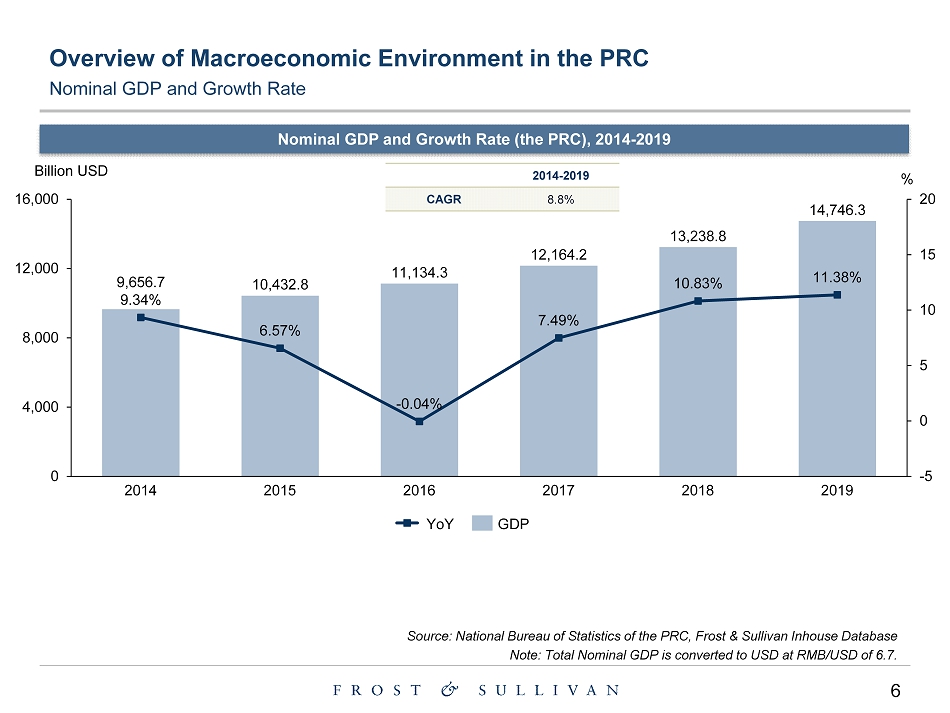
Overview of Macroeconomic Environment in the PRC Nominal GDP and Growth Rate Nominal GDP and Growth Rate (the PRC), 2014 - 2019 1 0 ,4 3 2.8 1 1 ,1 3 4.3 1 2 ,1 6 4.2 1 3 ,2 3 8.8 1 4 ,7 4 6.3 - 5 0 5 10 15 20 0 4 , 0 0 0 8 , 0 0 0 1 2 , 0 0 0 1 6 , 0 0 0 6.57% Billion USD 11.38% 2016 % 9,656.7 9.34% 2015 2014 - 0.04% 7.49% 2017 10.83% 2018 2019 Y oY 6 G D P Source: National Bureau of Statistics of the PRC, Frost & Sullivan Inhouse Database Note: Total Nominal GDP is converted to USD at RMB/USD of 6.7. 2014 - 2019 CAGR 8.8%

• According to the National Bureau of Statistics of the PRC, from 2014 to 2019 , nominal GDP per capita in the PRC rose from USD 7 , 701 . 7 in 2014 to USD 10 , 580 . 9 in 2019 , representing a CAGR of approximately 6 . 6 % . The growth in nominal GDP per capita is in line with the growth of nominal GDP from 2014 to 2019 . Source: National Bureau of Statistics of the PRC, Frost & Sullivan Inhouse Database Note: Nominal GDP per capita is converted to USD at RMB/USD of 6.7. Overview of Macroeconomic Environment in the PRC Nominal GDP per Capita Nominal GDP per Capita (the PRC), 2014 - 2019 2014 - 2019 CAGR 6.6% 7,701.7 7 8,166.8 8,115.8 8,677.4 1 0 ,5 8 0.9 9,608.4 0 4 , 0 0 0 8 , 0 0 0 USD 12,000 2014 2016 2019 2015 2017 2018
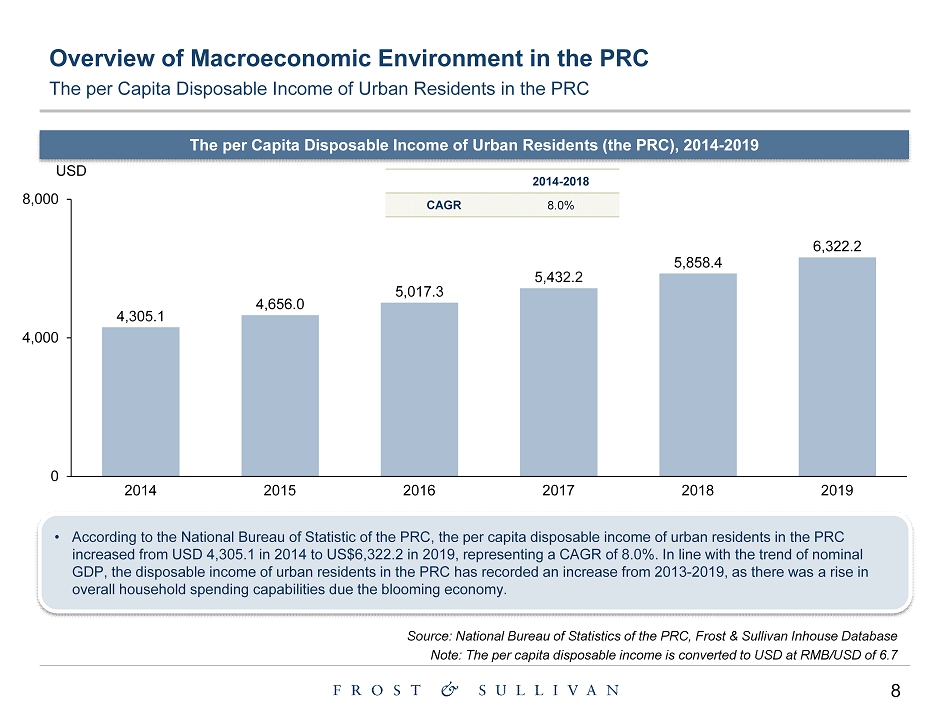
• According to the National Bureau of Statistic of the PRC, the per capita disposable income of urban residents in the PRC increased from USD 4,305.1 in 2014 to US$6,322.2 in 2019, representing a CAGR of 8.0%. In line with the trend of nominal GDP, the disposable income of urban residents in the PRC has recorded an increase from 2013 - 2019, as there was a rise in overall household spending capabilities due the blooming economy. Source: National Bureau of Statistics of the PRC, Frost & Sullivan Inhouse Database Note: The per capita disposable income is converted to USD at RMB/USD of 6.7 Overview of Macroeconomic Environment in the PRC The per Capita Disposable Income of Urban Residents in the PRC The per Capita Disposable Income of Urban Residents (the PRC), 2014 - 2019 2014 - 2018 CAGR 8.0% 4,305.1 8 4,656.0 5,017.3 5,432.2 5,858.4 6,322.2 0 4 , 0 0 0 2019 2015 2016 USD 8,000 2014 2017 2018

Overview of Enterprise Service Market in the PRC Definition and Market Size Market Size of Enterprise Service by Revenue (the PRC), 2014 - 2023E CAGR 2014 - 2018 2019E - 2023E Market Size 8.8% 9.4% 1 4 1.3 1 5 6.4 1 7 3.1 1 8 8.9 1 9 8.3 2 1 1.6 2 2 2.3 2 4 7.3 2 7 2.9 3 0 3.5 150 300 450 Billion RMB 0 2014 2015 2016 2017 2018 2019E 2020E 2021E 2022E 2023E • Enterprise service refers to consulting and training services provided to clients with the aim of helping clients develop business strategies and solutions. From 2014 to 2018, revenue of enterprise service market in the PRC experienced a steady growth from RMB141.3 billion (approximately US$20.5 billion) in 2014 to RMB198.3 billion (approximately US$28.7 billion) in 2018, representing a Compound Annual Growth Rate (“CAGR”) of approximately 8.8%. Supported by the further integration with knowledge sharing market and rapid development of knowledge sharing platform, revenue of enterprise service market participants is projected to rise at a CAGR of approximately 9.4%, attaining RMB303.5 billion (approximately US$44.0 billion) by the end of 2023. Source: Frost & Sullivan Inhouse Database 9
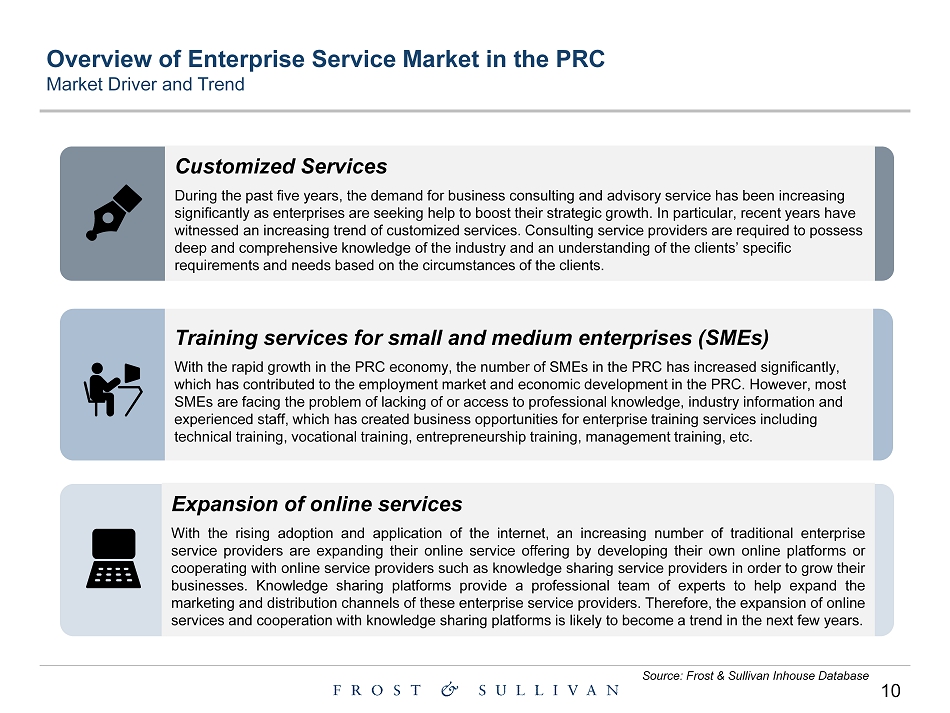
Customized Services During the past five years, the demand for business consulting and advisory service has been increasing significantly as enterprises are seeking help to boost their strategic growth. In particular, recent years have witnessed an increasing trend of customized services. Consulting service providers are required to possess deep and comprehensive knowledge of the industry and an understanding of the clients’ specific requirements and needs based on the circumstances of the clients. Lorem Ipsum Dolor Sit Er Elit Lamet, Consectetaur Cillium Adipisicing Pecu, Sed Do Eiusmod Tempor Incididunt Ut Labore Et Dolore Magna Aliqua. Consectetaur Cillium , ᵾ⳺䗮 ˈ ањн⭈ᒣ ᓨⲴ䙇∄ ʽ ww.tretars.com . Training services for small and medium enterprises (SMEs) With the rapid growth in the PRC economy, the number of SMEs in the PRC has increased significantly, which has contributed to the employment market and economic development in the PRC. However, most SMEs are facing the problem of lacking of or access to professional knowledge, industry information and experienced staff, which has created business opportunities for enterprise training services including technical training, vocational training, entrepreneurship training, management training, etc. Expansion of online services With the rising adoption and application of the internet, an increasing number of traditional enterprise service providers are expanding their online service offering by developing their own online platforms or cooperating with online service providers such as knowledge sharing service providers in order to grow their businesses . Knowledge sharing platforms provide a professional team of experts to help expand the marketing and distribution channels of these enterprise service providers . Therefore, the expansion of online services and cooperation with knowledge sharing platforms is likely to become a trend in the next few years . Overview of Enterprise Service Market in the PRC Market Driver and Trend Source: Frost & Sullivan Inhouse Database 10

Overview of Enterprise Service Market in the PRC Competitor Landscape 11 Market Participants Year of Establishment Country Description ATIF Holdings Limited (NASDAQ: ATIF) 2015 The PRC A comprehensive financial consulting group providing consulting and training services for enterprises. In 2019, the group has gone public on NASDAQ. Dark Horse Venture (Beijing) Technology Co . Ltd (SZSE : 300688 ) 2008 The PRC A company focusing on consulting and training services of entrepreneurship and innovation. It cooperates with industry experts, professionals and mentors to provide unique industrial resources to its members including entrepreneurs and enterprises. • The enterprise service market in the PRC is considered as a highly competitive and fragmented market . By the end of 2018 , there are around 0 . 9 million enterprise platforms . As the economy in the PRC continues to expand, more and more enterprise in the PRC require enterprise services to boost their business growth rate . It is expected that those enterprise services providers with competitive strategies, well - established business relationships, high - quality and customized services and access to industry professionals will expand market share and become leading market participants in the enterprise services market in the PRC . Source: Frost & Sullivan Inhouse Database

Agenda 2 Overview of the Enterprise Service Market in the PRC 3 Overview of the Knowledge Sharing Service Market in the PRC 1 Background of the Research 4 Appendix 12
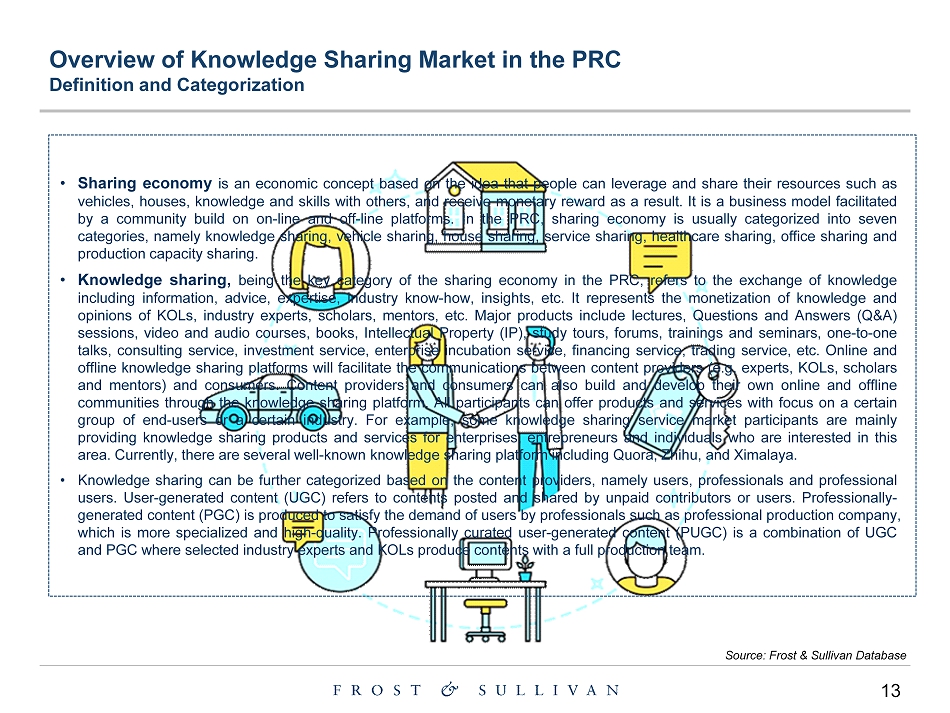
Overview of Knowledge Sharing Market in the PRC Definition and Categorization Source: Frost & Sullivan Database • Sharing economy is an economic concept based on the idea that people can leverage and share their resources such as vehicles, houses, knowledge and skills with others, and receive monetary reward as a result . It is a business model facilitated by a community build on on - line and off - line platforms . In the PRC, sharing economy is usually categorized into seven categories, namely knowledge sharing, vehicle sharing, house sharing, service sharing, healthcare sharing, office sharing and production capacity sharing . • Knowledge sharing, being the key category of the sharing economy in the PRC, refers to the exchange of knowledge including information, advice, expertise, industry know - how, insights, etc . It represents the monetization of knowledge and opinions of KOLs, industry experts, scholars, mentors, etc . Major products include lectures, Questions and Answers (Q&A) sessions, video and audio courses, books, Intellectual Property (IP), study tours, forums, trainings and seminars, one - to - one talks, consulting service, investment service, enterprise incubation service, financing service, trading service, etc . Online and offline knowledge sharing platforms will facilitate the communications between content providers (e . g . experts, KOLs, scholars and mentors) and consumers . Content providers and consumers can also build and develop their own online and offline communities through the knowledge sharing platform . All participants can offer products and services with focus on a certain group of end - users or a certain industry . For example, some knowledge sharing service market participants are mainly providing knowledge sharing products and services for enterprises, entrepreneurs and individuals who are interested in this area . Currently, there are several well - known knowledge sharing platform including Quora, Zhihu, and Ximalaya . • Knowledge sharing can be further categorized based on the content providers, namely users, professionals and professional users . User - generated content (UGC) refers to contents posted and shared by unpaid contributors or users . Professionally - generated content (PGC) is produced to satisfy the demand of users by professionals such as professional production company, which is more specialized and high - quality . Professionally curated user - generated content (PUGC) is a combination of UGC and PGC where selected industry experts and KOLs produce contents with a full production team . 13
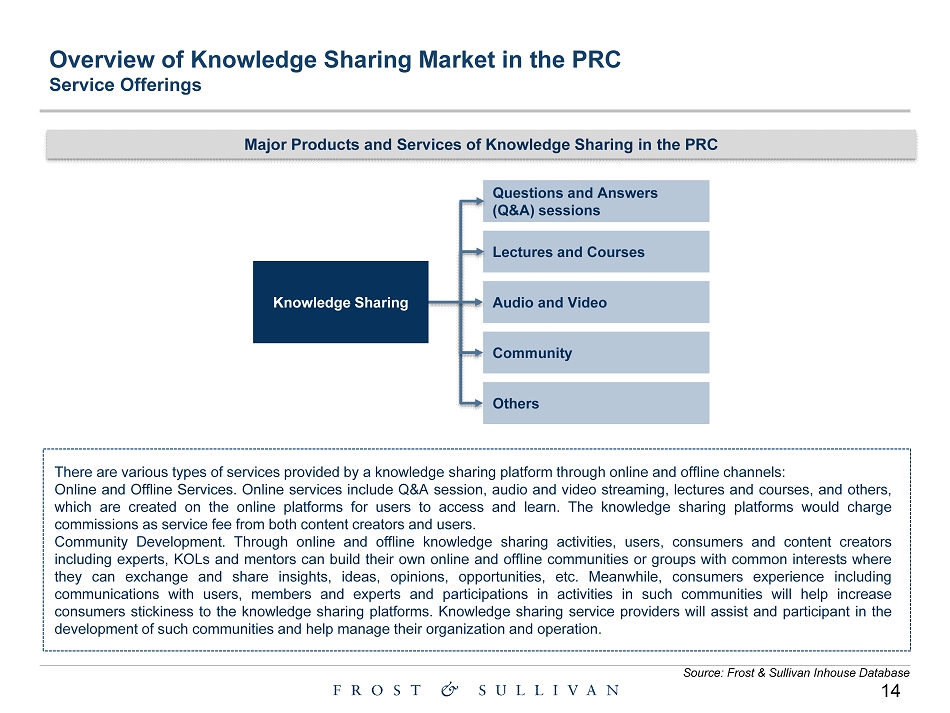
Overview of Knowledge Sharing Market in the PRC Service Offerings Major Products and Services of Knowledge Sharing in the PRC Knowledge Sharing Questions and Answers (Q&A) sessions Lectures and Courses Audio and Video Community Others There are various types of services provided by a knowledge sharing platform through online and offline channels : Online and Offline Services . Online services include Q&A session, audio and video streaming, lectures and courses, and others, which are created on the online platforms for users to access and learn . The knowledge sharing platforms would charge commissions as service fee from both content creators and users . Community Development . Through online and offline knowledge sharing activities, users, consumers and content creators including experts, KOLs and mentors can build their own online and offline communities or groups with common interests where they can exchange and share insights, ideas, opinions, opportunities, etc . Meanwhile, consumers experience including communications with users, members and experts and participations in activities in such communities will help increase consumers stickiness to the knowledge sharing platforms . Knowledge sharing service providers will assist and participant in the development of such communities and help manage their organization and operation . Source: Frost & Sullivan Inhouse Database 14
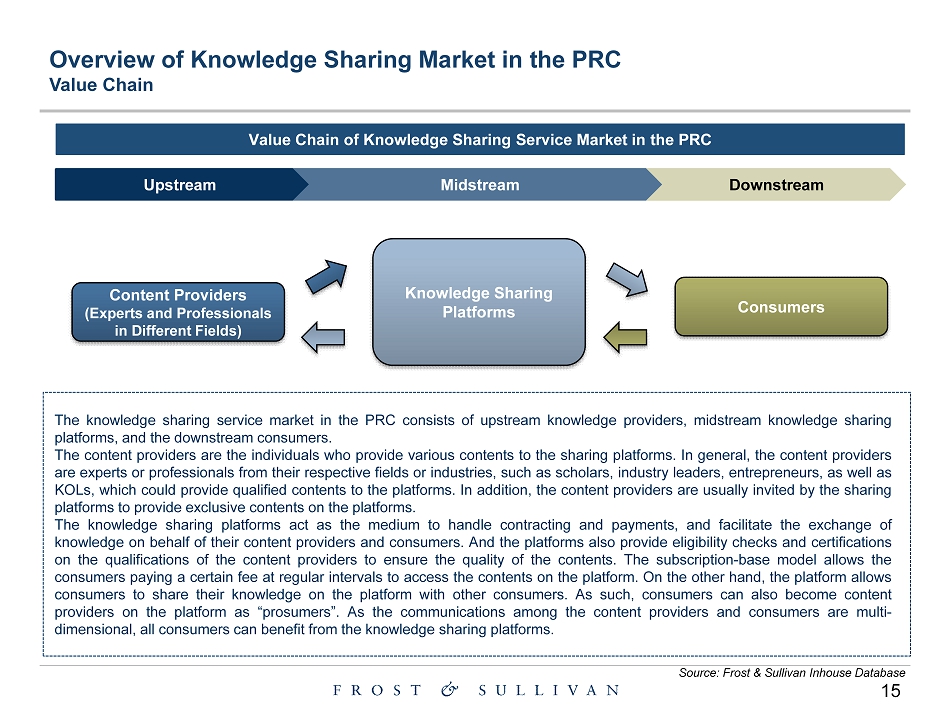
Value Chain of Knowledge Sharing Service Market in the PRC U pstre a m M ids tre a m D o w ns tre a m Knowledge Sharing Platforms Content Providers (Experts and Professionals in Different Fields) Consumers Overview of Knowledge Sharing Market in the PRC Value Chain The knowledge sharing service market in the PRC consists of upstream knowledge providers, midstream knowledge sharing platforms, and the downstream consumers . The content providers are the individuals who provide various contents to the sharing platforms . In general, the content providers are experts or professionals from their respective fields or industries, such as scholars, industry leaders, entrepreneurs, as well as KOLs, which could provide qualified contents to the platforms . In addition, the content providers are usually invited by the sharing platforms to provide exclusive contents on the platforms . The knowledge sharing platforms act as the medium to handle contracting and payments, and facilitate the exchange of knowledge on behalf of their content providers and consumers . And the platforms also provide eligibility checks and certifications on the qualifications of the content providers to ensure the quality of the contents . The subscription - base model allows the consumers paying a certain fee at regular intervals to access the contents on the platform . On the other hand, the platform allows consumers to share their knowledge on the platform with other consumers . As such, consumers can also become content providers on the platform as “prosumers” . As the communications among the content providers and consumers are multi - dimensional, all consumers can benefit from the knowledge sharing platforms . Source: Frost & Sullivan Inhouse Database 15

Overview of Knowledge Sharing Market in the PRC Market Size Note:Trading volume of knowledge sharing market includes revenue of knowledge sharing platforms, income of content creators, and other monetization income that is generated through knowledge sharing 16 Source: State Information Center,, Frost & Sullivan Inhouse Database Trading Volume of Knowledge Sharing Market (the PRC), 2014 - 2023E CAGR 2014 - 2018 2019E - 2023E Trading Volume 122.2% 56.1% 9.6 2 0 .0 6 1 .0 1 3 8.2 2 3 5.3 5 5 6.1 355.1 8 5 2.2 1,359.1 2,107.5 0 800 1 , 6 0 0 Billion RMB 2,400 2014 2015 2016 2017 2018 2019E 2020E 2021E 2022E 2023E • Driven by the increasing demand for high - quality knowledge products and services, rising education levels of consumers, from 2014 to 2018, total trading value of knowledge sharing market in the PRC grew dramatically from RMB9.6 billion(approximately US$1.4 billion) in 2014 to RMB235.3 billion (approximately US$34.1 billion) in 2018, representing a CAGR of approximately 122.2% during the period. Looking forward, supported by growth of disposable income and decentralization of content production, knowledge sharing market in the PRC is expected to record RMB2,107.5 billion (approximately US$305.4 billion) by the end of 2023, with a CAGR of approximately 56.1% from 2019.

Overview of Knowledge Sharing Market in the PRC Market Drivers Favorable macroeconomic environment driving the growth of knowledge sharing platform . The overall economic environment and the rising household income have demonstrated a stable growth over the past few years and such growth is expected to sustain in the next few years . Undoubtedly, the trend will improve people’s living standards and also guarantees a growing consumption demand and people’s demand for information and knowledge that would continue brings improvement to their current living standards . The above factors are likely to further drive the growth of knowledge sharing service in China . Technology innovation and data availability The advancement in technology is one of the essential success factors that drove the rapid development of the knowledge sharing service market . With the help of new technologies, the knowledge sharing platforms are able to target audience effectively and efficiently, monitor data traffic constantly and adjust the contents instantly to stay competitive in the current market . This would be one of the key driving forces of the market development of knowledge sharing service in the future . Exploitation of big data . Due to the increasing volume of internet data traffic, the ability to analyze data to obtain valuable insights has become increasingly important for knowledge sharing platforms to compete and survive in today’s market . Undoubtedly, with the aid of big data, knowledge sharing platforms are able to obtain various valuable user insights and accurately feed useful information to different users . This in turn generates various business opportunities for the knowledge sharing platforms . 1 17 2 3 Source: Frost & Sullivan Inhouse Database
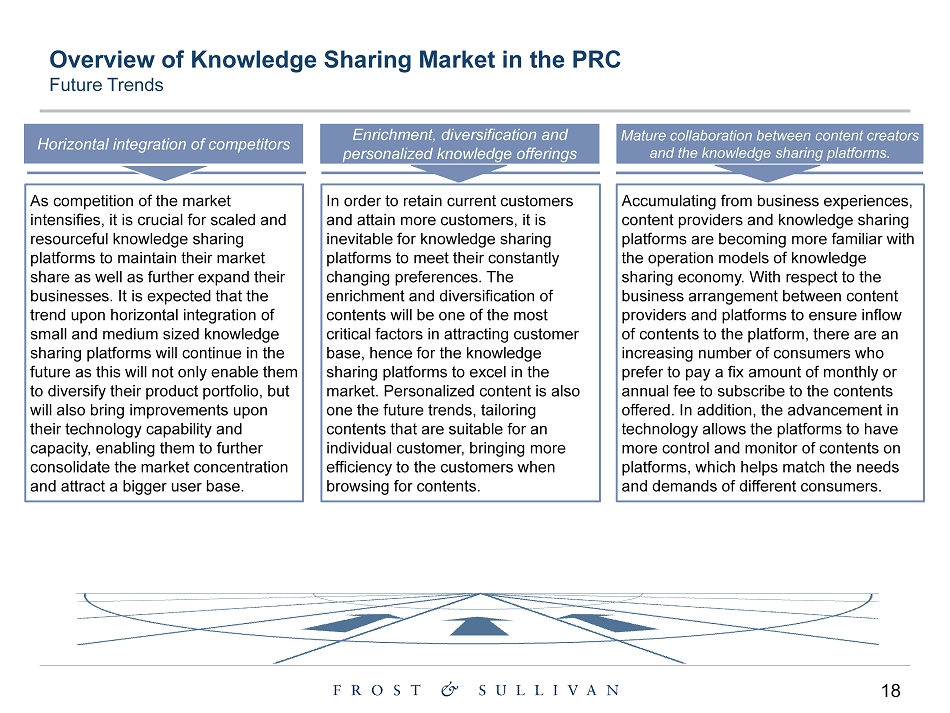
Overview of Knowledge Sharing Market in the PRC Future Trends In order to retain current customers and attain more customers, it is inevitable for knowledge sharing platforms to meet their constantly changing preferences. The enrichment and diversification of contents will be one of the most critical factors in attracting customer base, hence for the knowledge sharing platforms to excel in the market. Personalized content is also one the future trends, tailoring contents that are suitable for an individual customer, bringing more efficiency to the customers when browsing for contents. As competition of the market intensifies, it is crucial for scaled and resourceful knowledge sharing platforms to maintain their market share as well as further expand their businesses. It is expected that the trend upon horizontal integration of small and medium sized knowledge sharing platforms will continue in the future as this will not only enable them to diversify their product portfolio, but will also bring improvements upon their technology capability and capacity, enabling them to further consolidate the market concentration and attract a bigger user base. Accumulating from business experiences, content providers and knowledge sharing platforms are becoming more familiar with the operation models of knowledge sharing economy. With respect to the business arrangement between content providers and platforms to ensure inflow of contents to the platform, there are an increasing number of consumers who prefer to pay a fix amount of monthly or annual fee to subscribe to the contents offered. In addition, the advancement in technology allows the platforms to have more control and monitor of contents on platforms, which helps match the needs and demands of different consumers. Enrichment, diversification and personalized knowledge offerings Mature collaboration between content creators and the knowledge sharing platforms. Horizontal integration of competitors 18
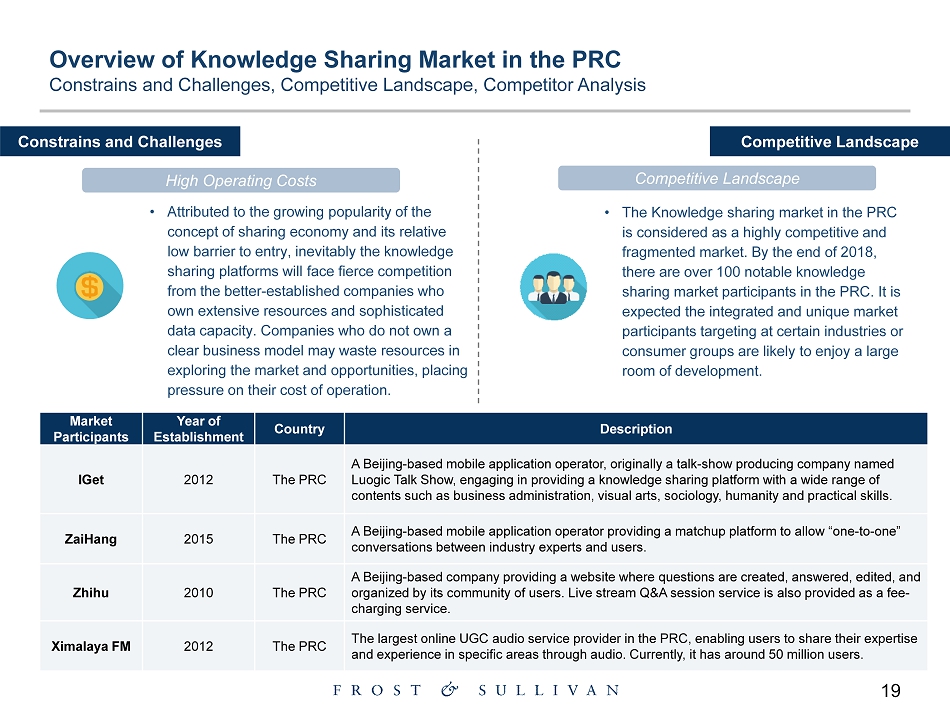
19 Overview of Knowledge Sharing Market in the PRC Constrains and Challenges, Competitive Landscape, Competitor Analysis Market Participants Year of Establishment Count r y Description IGet 2012 The PRC A Beijing - based mobile application operator, originally a talk - show producing company named Luogic Talk Show, engaging in providing a knowledge sharing platform with a wide range of contents such as business administration, visual arts, sociology, humanity and practical skills. ZaiHang 2015 The PRC A Beijing - based mobile application operator providing a matchup platform to allow “one - to - one” conversations between industry experts and users. Zhihu 2010 The PRC A Beijing - based company providing a website where questions are created, answered, edited, and organized by its community of users. Live stream Q&A session service is also provided as a fee - charging service. Ximalaya FM 2012 The PRC The largest online UGC audio service provider in the PRC, enabling users to share their expertise and experience in specific areas through audio. Currently, it has around 50 million users. Constrains and Challenges High Operating Costs • Attributed to the growing popularity of the concept of sharing economy and its relative low barrier to entry, inevitably the knowledge sharing platforms will face fierce competition from the better - established companies who own extensive resources and sophisticated data capacity. Companies who do not own a clear business model may waste resources in exploring the market and opportunities, placing pressure on their cost of operation. Competitive Landscape Competitive Landscape • The Knowledge sharing market in the PRC is considered as a highly competitive and fragmented market. By the end of 2018, there are over 100 notable knowledge sharing market participants in the PRC. It is expected the integrated and unique market participants targeting at certain industries or consumer groups are likely to enjoy a large room of development.
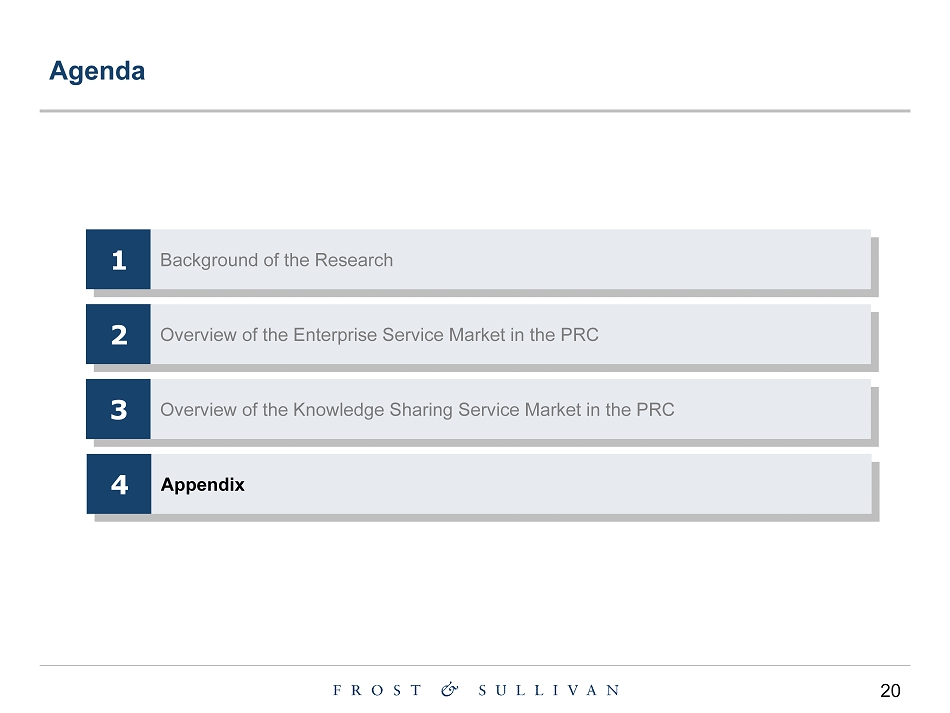
Agenda 2 Overview of the Enterprise Service Market in the PRC 3 Overview of the Knowledge Sharing Service Market in the PRC 1 Background of the Research 4 A pp e nd ix 20
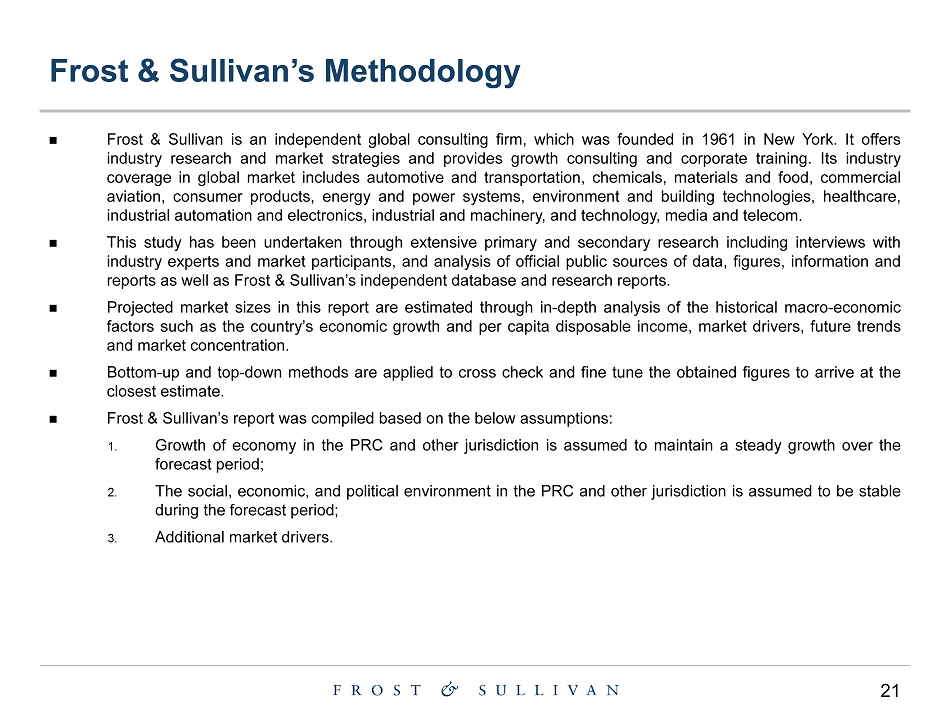
Frost & Sullivan’s Methodology 21 x x x x x Frost & Sullivan is an independent global consulting firm, which was founded in 1961 in New York . It offers industry research and market strategies and provides growth consulting and corporate training . Its industry coverage in global market includes automotive and transportation, chemicals, materials and food, commercial aviation, consumer products, energy and power systems, environment and building technologies, healthcare, industrial automation and electronics, industrial and machinery, and technology, media and telecom . This study has been undertaken through extensive primary and secondary research including interviews with industry experts and market participants, and analysis of official public sources of data, figures, information and reports as well as Frost & Sullivan’s independent database and research reports . Projected market sizes in this report are estimated through in - depth analysis of the historical macro - economic factors such as the country’s economic growth and per capita disposable income, market drivers, future trends and market concentration . Bottom - up and top - down methods are applied to cross check and fine tune the obtained figures to arrive at the closest estimate . Frost & Sullivan’s report was compiled based on the below assumptions : 1. 2. 3. Growth of economy in the PRC and other jurisdiction is assumed to maintain a steady growth over the forecast period; The social, economic, and political environment in the PRC and other jurisdiction is assumed to be stable during the forecast period; Additional market drivers.
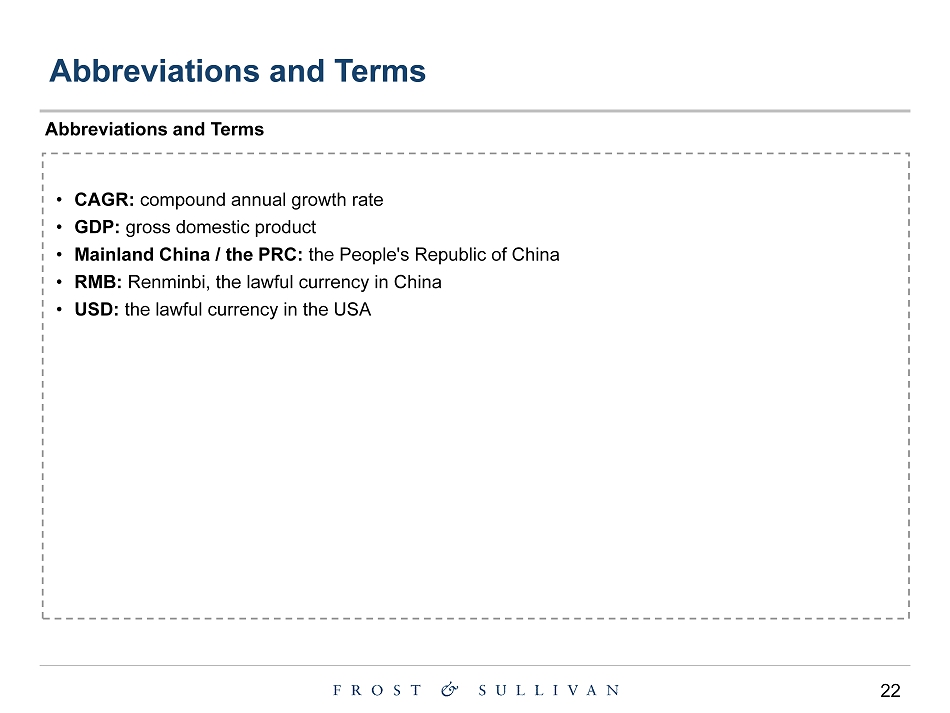
Abbreviations and Terms Abbreviations and Terms • CAGR: compound annual growth rate • GDP: gross domestic product • Mainland China / the PRC: the People's Republic of China • RMB: Renminbi, the lawful currency in China • USD: the lawful currency in the USA 22

Thank You! 23